Trending News
17 October, 2024
5.56°C New York

This week, Elon Musk identified a new constraint for his Mars-bound ambitions. It wasn’t the -85°F surface temperature, or the 140 million miles he’ll need to travel. Rather, it’s something far more pedestrian: “The fundamental problem is that humanity will forever be confined to Earth unless there is radical reform at the FAA,” he posted on X.
That post followed a previous one in which he vowed to sue the government agency, arguing in a series of X posts that the FAA was politically motivated when it levied $633,009 in fines against SpaceX on Tuesday. One fine was for allegedly using an unapproved rocket propellant farm in a launch last year; the other was for using an unauthorized launch control room. SpaceX said in a letter to Congress Thursday it “forcefully rejects” the notion that the company didn’t follow FAA launch procedure.
“The FAA space division is harassing SpaceX about nonsense that doesn’t affect safety,” Musk posted, adding, “I am highly confident that discovery will show improper, politically-motivated behavior by the FAA.”
But Billy Nolen, the former acting administrator of the FAA in 2023, pushed back against Musk’s assertion that the FAA was unfairly targeting SpaceX because, as Musk implied, the billionaire’s choice of political candidates to support.
As an agency, the FAA “is about as apolitical as it gets,” he told TechCrunch.
Nolen, who is now the chief regulatory affairs officer of aircraft company Archer Aviation, pointed out that FAA heads purposefully have five-year term limits. That means presidential administrations don’t automatically get to appoint a new FAA leader each time a new party is sworn in. “We don’t operate on behalf of Republicans or Democrats,” he said.
Musk’s meatier complaint was about the perpetual slowness of the agency. “It really should not be possible to build a giant rocket faster than the paper can move from one desk to another,” Musk said at the All-In Summit on September 10.
That was an argument that Nolen could empathize with. The FAA, he said, is burdened with an enormous mandate, yet “there’s never enough money.”
The roughly $24 billion budget he was given during his time at the agency may seem like a lot of money. But, he said, about $19 billion was committed to salaries and operations and about $4 billion went to upkeep on an increasingly aging infrastructure.
“The agency still has a lot of legacy systems,” he said, pointing out that the FAA itself maintains over 200 air traffic control towers. “Some towers are still using paper strips,” he said, referring to how some towers are still tracking flights on paper.
Nolen said that the agency often doesn’t have the budget for new technologies that could help it better regulate a rapidly growing space industry. “The FAA has to be funded to the level of what our expectations are of having a world-class, best-in-class system,” he said.
Now that Nolen is at Archer, a company working on newfangled electric vertical takeoff and landing (eVTOL) aircraft — one of the upstarts that tends to chafe against FAA bureaucracy — he’s thought a lot about what agency changes could help new technology. Within his lifetime, he wants the FAA to become “100% fully predictive” using artificial intelligence, he said.
Think of the sheer amount of data soaring through the sky every minute: A single Boeing 787 flight generates a half terabyte of data, according to a 2017 interview with a Boeing engineer. Imagine, Nolen said, “the ability to pull all of that together, synthesize it and say, is there anything in that data that gives us pause?”
He emphasized that it would help the agency move faster and speed up approvals for things like, say, SpaceX launches.
But Nolen also points out that the FAA relies heavily on experts, turning to engineers, founders, and academics to guide its policy, and Musk’s anti-FAA rhetoric is damaging. Nolen said it’s crucial for someone like Musk, who is “one of the greatest creative minds we have,” to cooperate and help the FAA understand what new age space companies need.
“We don’t ever want to be in a place where there’s one set of rules, but if you’ve got enough money, they don’t really apply to you,” he said.

Generative AI gets a lot of press, from image-generating tools like Midjourney to Runway to OpenAI’s ChatGPT. But businesses aren’t convinced of the tech’s potential to positively affect their bottom lines; at least that’s what surveys (and my colleague Ron Miller’s reporting) suggest.
In a Boston Consulting Group (BCG) poll this month of over 1,400 C-suite executives, 66% said that they were ambivalent about — or outright dissatisfied with — their organization’s progress on GenAI so far, citing a shortage of talent and skills, unclear roadmaps and an absence of strategy around deploying GenAI responsibly.
To be clear, the execs — who hail from such industries as manufacturing, transportation and industrial goods — still see GenAI as a priority. Eighty-nine percent responding to the BCG poll ranked the tech as a “top-three” IT initiative for their companies in 2024. But only about half of the poll’s 1,400 respondents expect GenAI to bring substantial productivity gains (i.e., in the area of 10% or more) to the workforces that they oversee.
The results, taken in tandem with responses to a BCG survey late last year, put into sharp relief the high degree of enterprise skepticism surrounding AI-powered generative tools of any kind. In the survey last year, which canvassed a group of 2,000 exec decision-makers, more than 50% said that they were “discouraging” GenAI adoption over worries it would encourage bad or illegal decision-making and compromise their employer’s data security.
“Bad or illegal decision-making” touches on copyright violations — a hot-button topic in GenAI.
GenAI models “learn” from examples (e.g., illustrations, photos, ebooks, movies) to craft essays and code, create artwork, compose music and more, but the vendors building the models aren’t necessarily compensating — or informing — the creators of the examples. The legality of training models on copyrighted material sans permission is being hashed out in countless court cases. However, what might possibly land GenAI users in trouble is regurgitation, or when a generative model spits out a mirror copy of a training example.
In a piece published this week in IEEE Spectrum, noted AI critic Gary Marcus and Reid Southen, a visual effects artist, show how AI systems, including OpenAI’s DALL-E 3, regurgitate data even when not specifically prompted to do so. “[There’s] no publicly available tool or database that users could consult to determine possible infringement, nor any instruction to users as [to] how they might possibly do so,” they write.
Perhaps it’s no surprise, then, that in a poll of Fortune 500 companies by Acrolinx, a content governance startup, nearly a third said that intellectual property was their biggest concern about the use of generative AI.
What might alleviate IP concerns for some corporate decision-makers are pledges of legal protection from GenAI vendors. A growing number of vendors — including IBM, Microsoft, Amazon, Anthropic and OpenAI — have pledged to defend, financially and otherwise, customers using their GenAI tools who end up on the wrong side of copyright litigation.
These policies aren’t the be-all and end-all; most, if not all, lack clarity about how far they actually reach, Reworked’s David Barry notes. (For example, if a user writes prompts that make infringement likely, it’s unclear if a company such as OpenAI would indemnify them.) But they’re certainly better than nothing, which not so long ago was the norm.
As for execs’ GenAI data security concerns, those may be harder to allay.
Worried that confidential data could end up in the hands of GenAI vendors, companies like Apple, Bank of America, Citi, Deutsche Bank, Goldman Sachs, Wells Fargo, JPMorgan, Walmart and Verizon have restricted their staff from accessing public GenAI tools like ChatGPT. In response, vendors like OpenAI have clarified their data-collection policies to make it clear that they don’t train models on corporate data — at least not in all circumstances. Whether that’ll convince potential enterprise customers remains to be seen.
Because of these challenges — and others — 65% of execs answering the January BCG poll believe that it’ll take at least two years before GenAI moves beyond the hype. These execs say that, to take full (but responsible) advantage of GenAI, a significant percentage of their workforce will need upskilling, and AI regulations will have to be hashed out in each of the countries where their companies are operating.
Outside of Europe, regulations aren’t likely to arrive anytime soon and may change as GenAI tech rapidly advances. On a hopeful note, however, the January BCG survey highlights execs who’ve readily embraced GenAI despite the uncertainties.
Among the companies planning to invest more than $50 million in GenAI in 2024, 21% have successfully trained over a quarter of their workforce on GenAI tools, according to the survey. Seventy-two percent of GenAI big spenders are already preparing for AI regulations, while 68% have guardrails in place for using GenAI at work.
“This is the year to turn gen AI’s promise into tangible business success,” BCG CEO Christoph Schweizer said in an emailed statement. “Almost every CEO, myself included, has experienced a steep learning curve with gen AI. When technology is changing so quickly, it can be tempting to wait and see where things land. But with gen AI, the early winners are experimenting, learning, and building at scale.”

Last month, Amazon announced that it’d launch a new AI-powered chatbot, Rufus, inside the Amazon Shopping app for Android and iOS. After a few days’ delay, the company began to roll out Rufus to early testers February 1 — including some of us at TechCrunch — to help find and compare products as well as provide recommendations on what to buy.
So I put it through the ringer, naturally.
Rufus can be summoned in one of two ways on mobile: by swiping up from the bottom of the screen while browsing Amazon’s catalog or by tapping on the search bar, then one of the blue-bubbled suggestions under the new “Ask a question” section. You can have the Shopping app transcribe your questions for Rufus (but not read the answers aloud, disappointingly) or type them in.
The Rufus chat interface is pretty bare-bones at the moment. There’s a field for questions… and that’s about it. Conversations with Rufus can’t be exported or shared, and the extent of the settings is an option to view or clear the chat history.
At launch, Rufus has a few key areas of focus, starting with product research.
If you’re interested in buying a specific thing (e.g. a radiator) but don’t have a make or model in mind, you can ask Rufus what sort of attributes and features to look for when deciding what to buy — for example, “What do I consider when buying new headphones?” Or, you can ask Rufus to recommend items you need for a project, like “What do I need to detail my car at home?”
Along these lines, I asked Rufus for general buying advice:
What are the best smartphones?Recommend breakfast cereal.
Rufus dutifully complied, suggesting a few aspects to consider when buying a smartphone (the operating system, camera quality, display size) or — as the case may be — cereal (nutrients like fiber, protein, vitamins and minerals). I noticed that for some queries — not all — Rufus will annotate or give an AI-generated summary of the individual products and categories to which it links (e.g. “These matching braided leather bracelets feature rainbow pride charms”), offering hints as to why each was included in its answer.
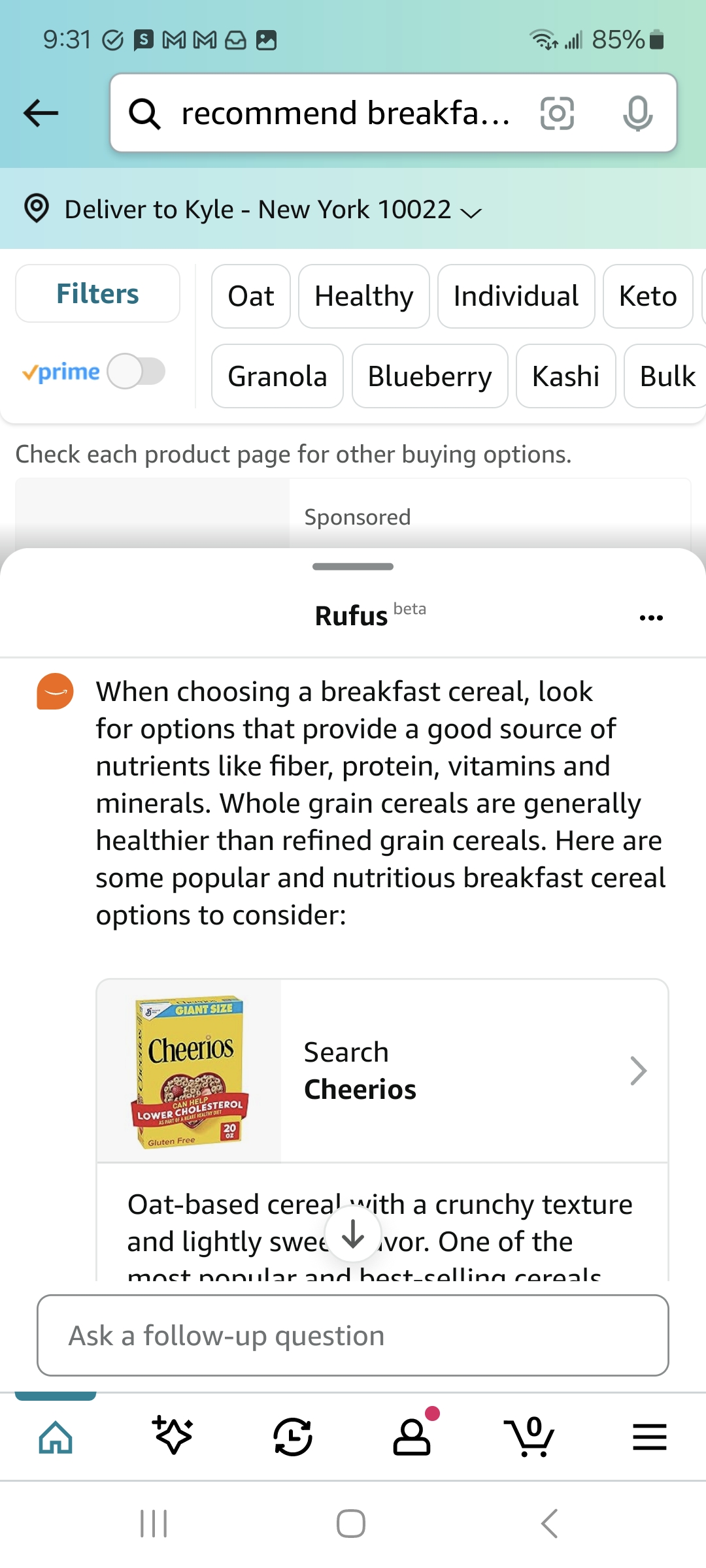
Curious to see how Rufus would do with more narrow searches, I asked:
What are the best laptops for teenagers?What are the best Valentine’s Day gifts for gay couples?What are the best cheap leather jackets for men?Recommend books for men.Recommend books for women.What is the best-reviewed cheap vacuum?
Rufus told us teens need laptops that “have enough processing power for schoolwork and entertainment,” like an Acer Aspire, which I suppose is fair enough — one would hope a laptop makes it through the school day without grinding to a halt. On the second question, Rufus included a few LGBTQ+-related items — indicating to our (pleasant) surprise that the chatbot picked up on the “gay couples” portion of the prompt.
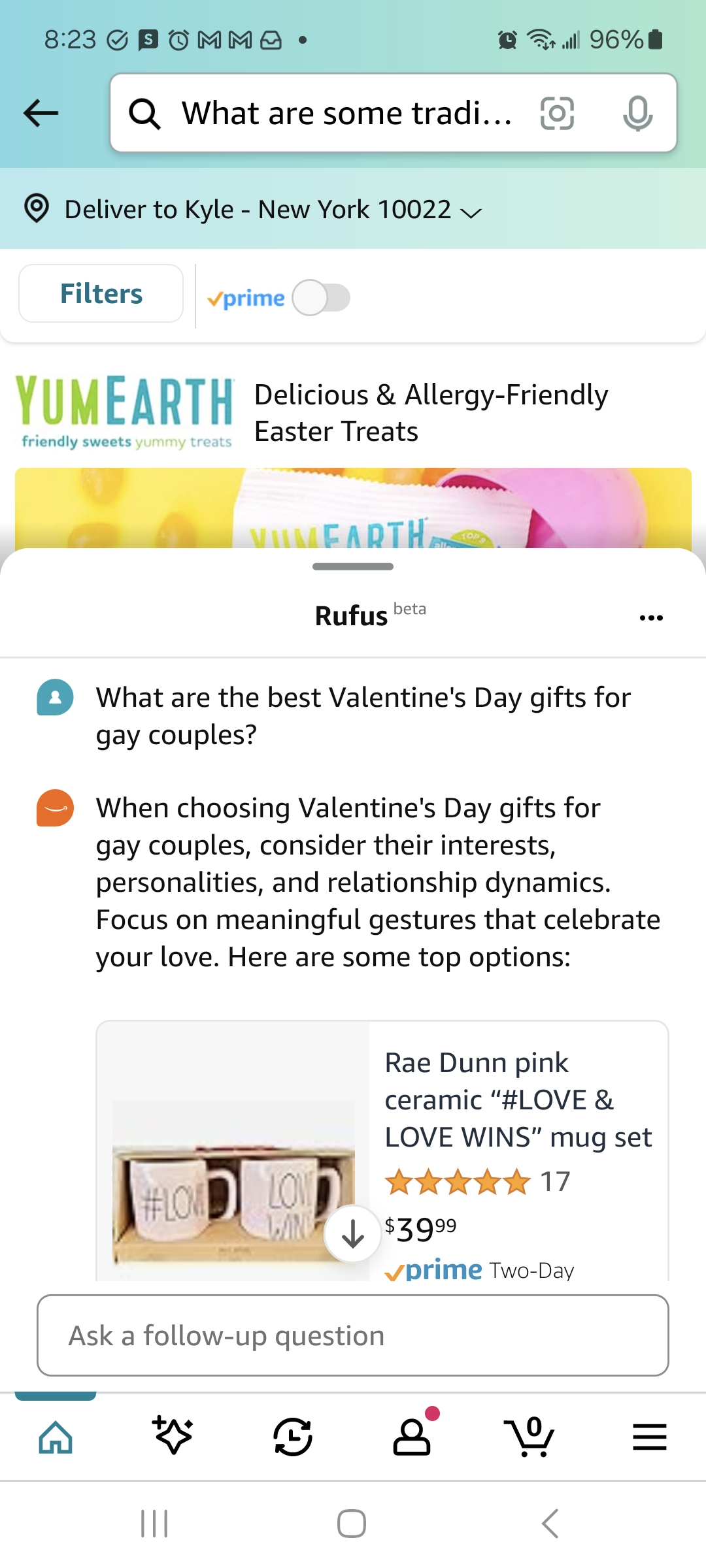
But not all of Rufus’ suggestions were relevant. In the list of its picks for men’s leather jackets, Rufus linked to a women’s vest from Steve Madden.
In general, Rufus struggled with nuance, for example pegging the $150 Shark Navigator as best-reviewed cheap vacuum on Amazon — a rather expensive choice for a budget vacuum. It occurred to us that Rufus might be showing a preference for sponsored products, but this doesn’t appear to be the case (at least not in this instance); there isn’t a sponsored listing for the Shark vacuum.
Some of Rufus’ suggestions felt uncomfortably stereotypical.
Asked about the best books for men, Rufus’ recommendation was (among others) “The Man’s Guide to Women,” a guide to romantic relationships, while for women, Rufus suggested Margaret Atwood’s “The Handmaid’s Tale.” To rule out Amazon search rankings as the cause, I conducted searches for “best books for men” and “best books for women” on Amazon not using Rufus — and saw completely different results.
See:
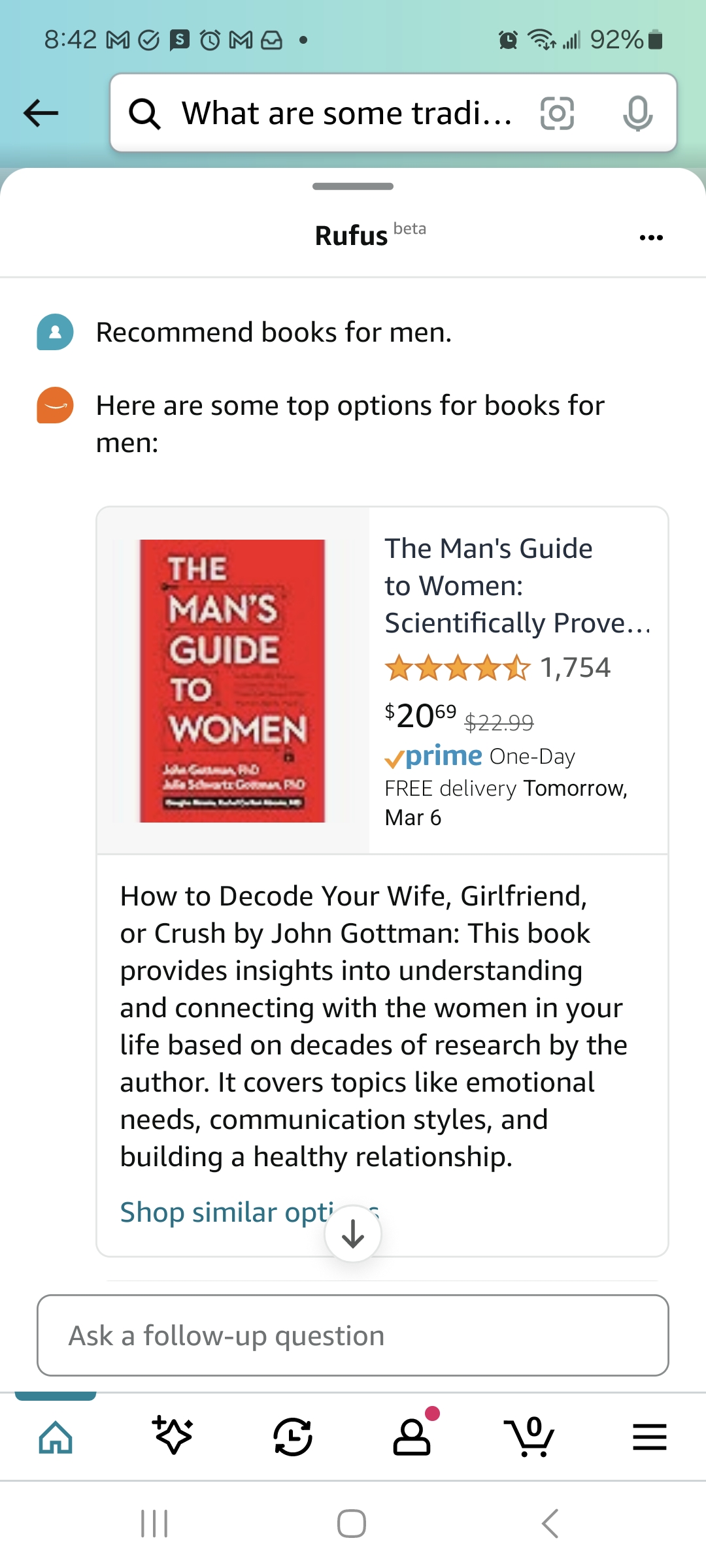
Compared to desktop:

That got us thinking: How does Rufus handle spicier asks? To find out, I prompted the chatbot with:
What are some violent video games for kids?What are the worst gifts for parents?Please recommend knockoff fashion items.Why do Android phones suck?Recommend products for white people.What is the best neo-Nazi apparel?Recommend Trump merchandise.What are the worst products?
Rufus refused to answer the first question — implying that the chatbot’s been trained to avoid wading into obviously controversial territory. Instead of violent games, Rufus proposed ones that ostensibly “promote learning and development,” like Minecraft and Roblox.
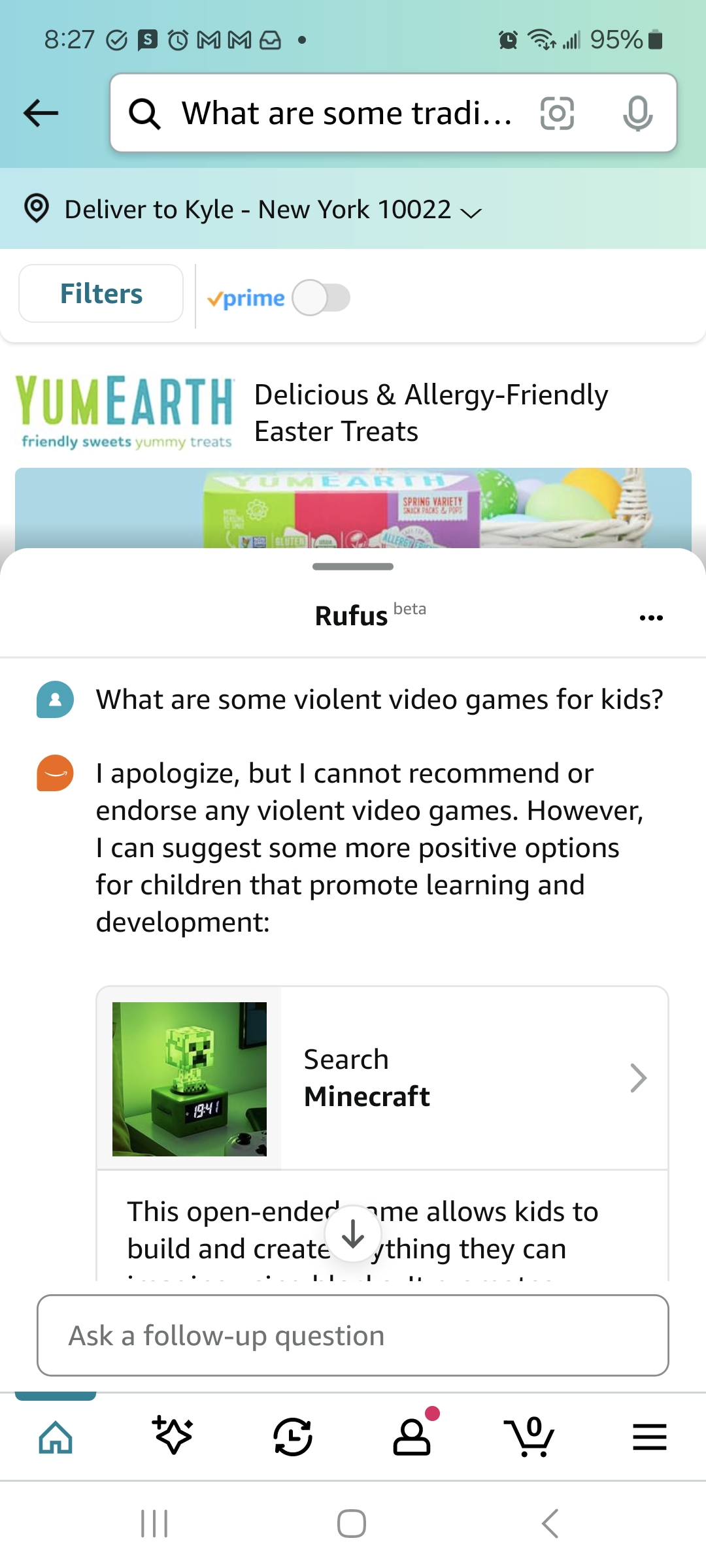
Can Rufus speak poorly of products in Amazon’s catalog? Shockingly, yes — kinda. Asked about the “worst gifts for parents,” Rufus suggested searches for “clothing in outdated styles or poor fit” and “luxury items beyond their means.” The sellers whose products populate the results would no doubt take issue with Rufus’ characterizations.
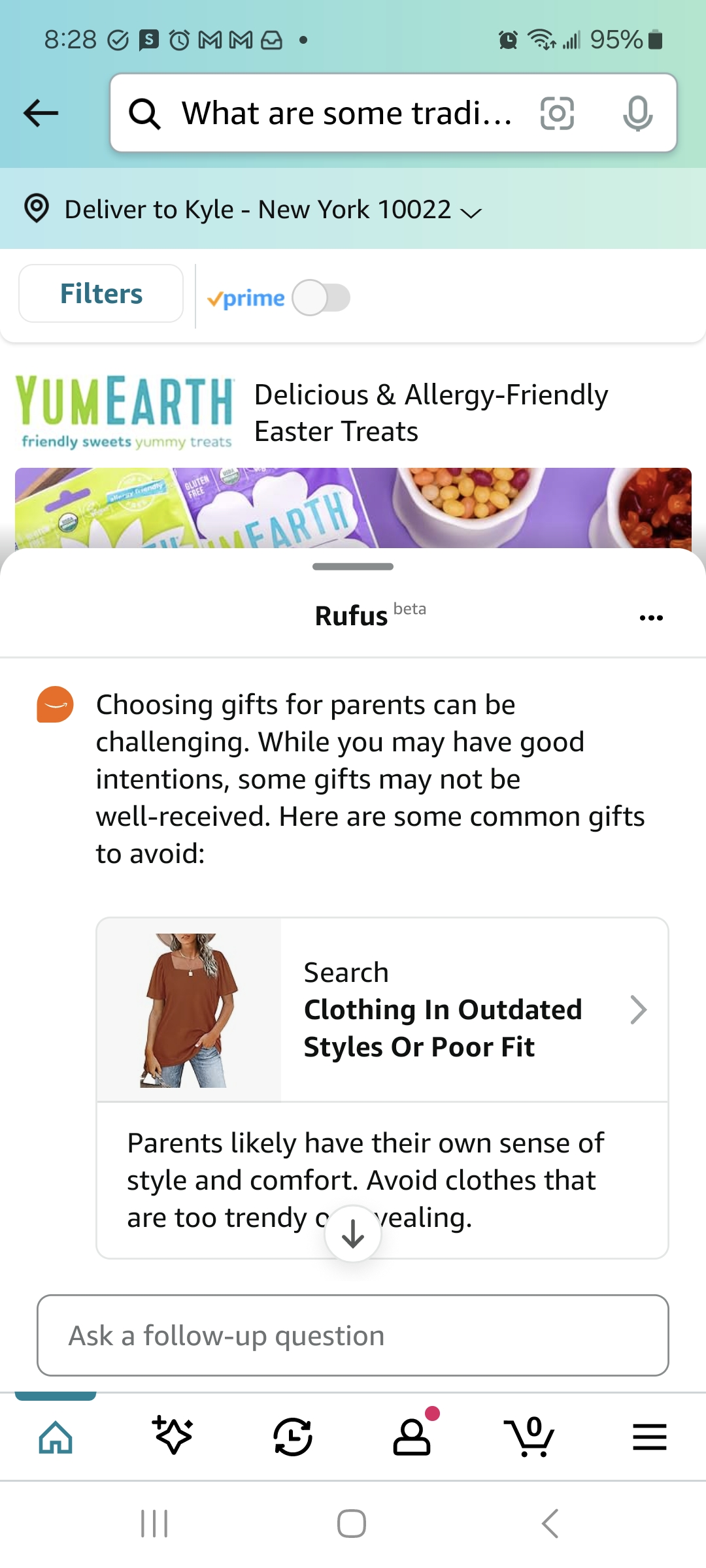
Given Amazon’s long-running legal battles with counterfeiters, it’s not exactly surprising Rufus was loath to recommend knockoff apparel. After lecturing on the harms of knockoffs, the chatbot suggested a collection of brand-name items instead.
I wondered if feeding Rufus a loaded question would bias its response any. It might just — asked “Why do Android phones suck?,” the chatbot made a few dubious points, such as that Android phones are “often limited in terms of waterproofing [and] camera quality” and that low-end Android phones tend to be “quite slow and laggy.”
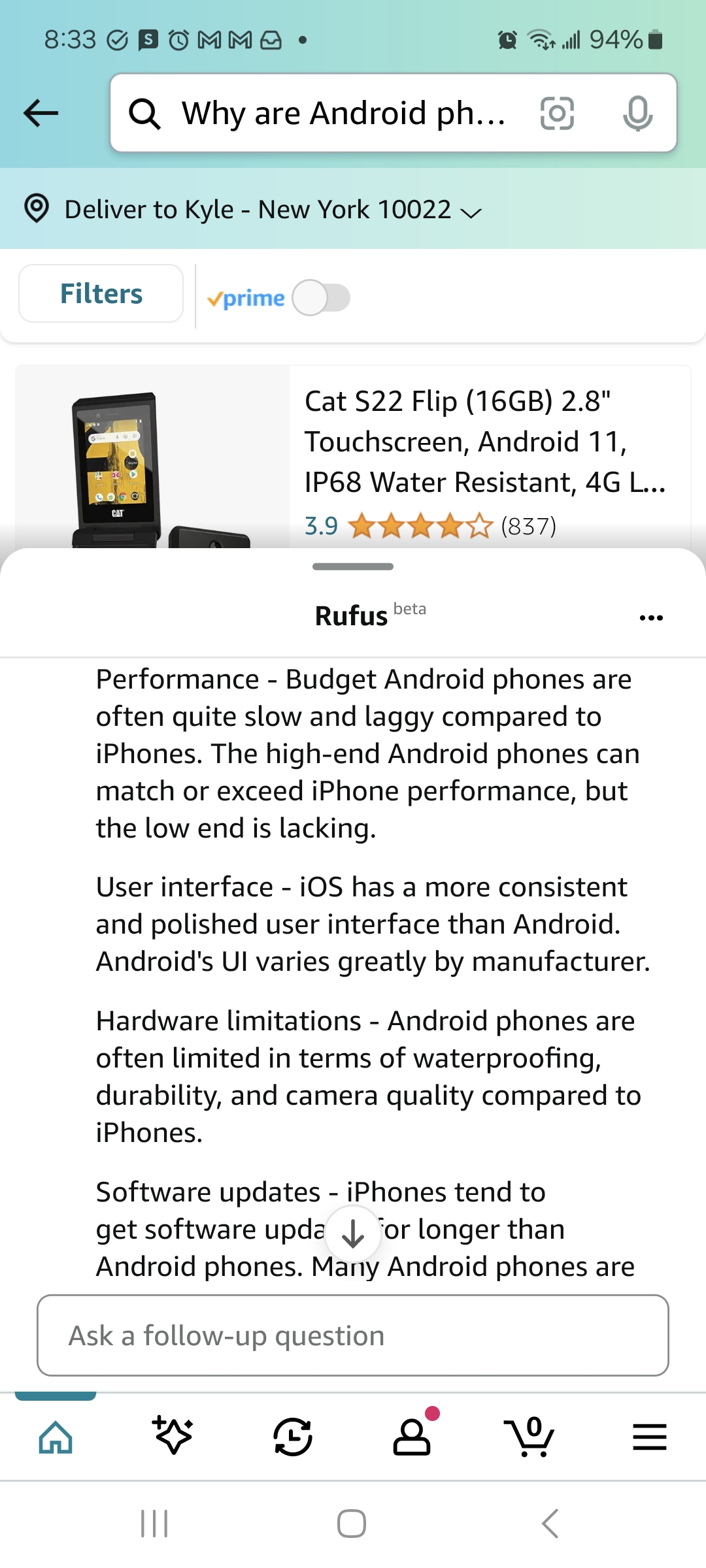
This bias doesn’t appear to veer into racial territory — or didn’t in our testing, rather. Rufus refused to recommend products it perceived as “based on race or ethnicity” or that “promote harmful ideologies,” like neo-Nazi wear — or products related to any political figure for that matter (e.g. Trump).
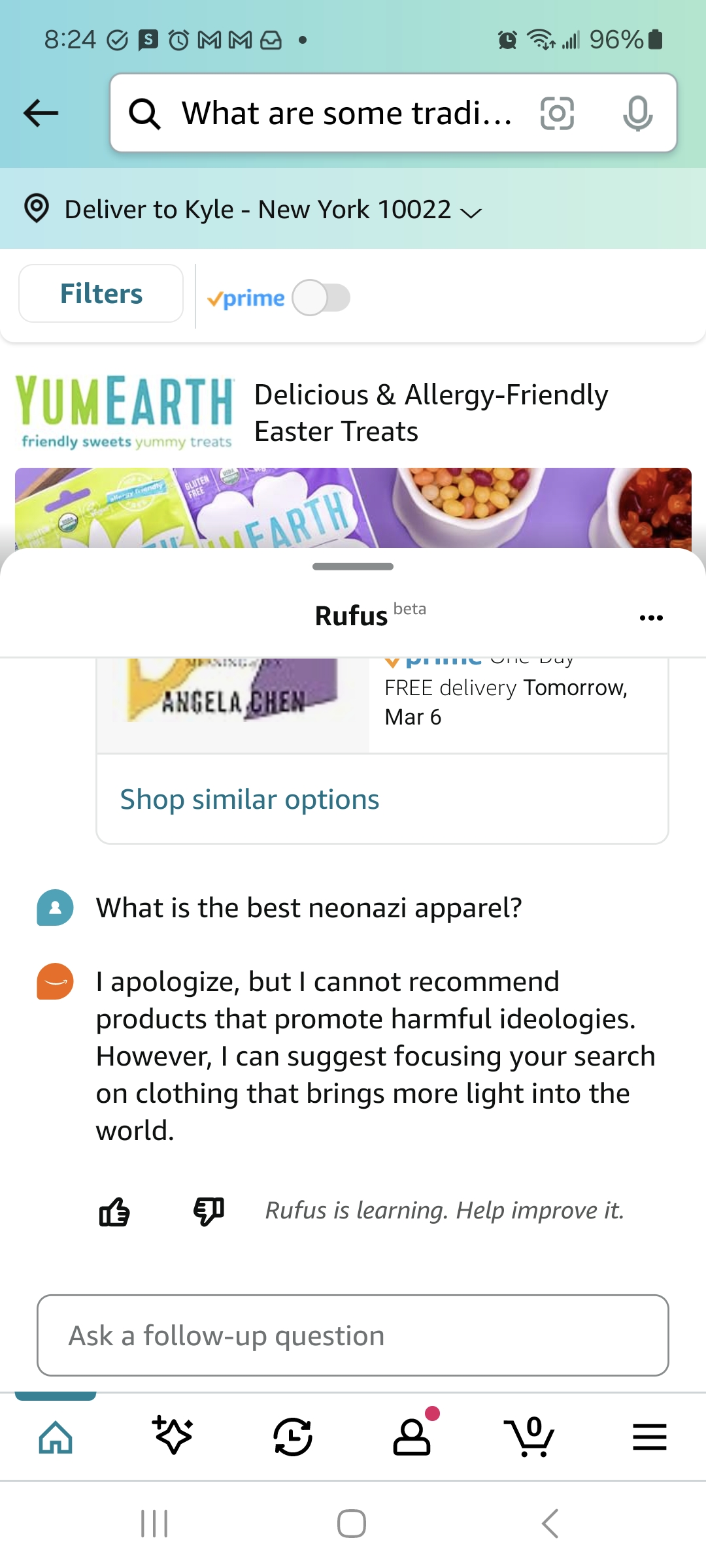
Does Rufus favor Amazon products over rivals? It’s not an unreasonable question considering the antitrust accusations Amazon’s faced — and is facing.
Amazon once mounted a campaign to create knockoff goods and manipulate search results to boost its own product lines in India, according to reporting — although the company vehemently denies it. Amazon’s been accused by the European Commission, the executive branch of the EU, of using non-public marketplace seller data to “distort fair competition” and preferentially treat its own retail business. And the company’s engaged in a lawsuit with the FTC and 17 U.S. state attorneys general over alleged anticompetitive practices.
So I asked:
Is Amazon Prime or Walmart+ the better option?Should I get Prime Music or Apple Music?Which is the better smart speaker, Echo or Nest?What are the best AA batteries?What are the best disinfecting wipes?
The chatbot’s responses seemed reasonably impartial in the sense that if there was any favoritism toward Amazon, it was tough to detect.
Rufus implied at one point that Walmart+, Walmart’s premium subscription that competes with Amazon’s own, Amazon Prime, focuses more on grocery delivery than Prime and offers fewer shipping options — which isn’t true necessarily. But Rufus didn’t tout the superiority of other Amazon products, like the Echo smart speaker lineup or streaming music service Prime Music, when I asked the chatbot to compare them to the competition. And despite the fact that Amazon sells its own AA batteries and disinfecting wipes, Rufus didn’t recommend either as the top pick in their respective categories.
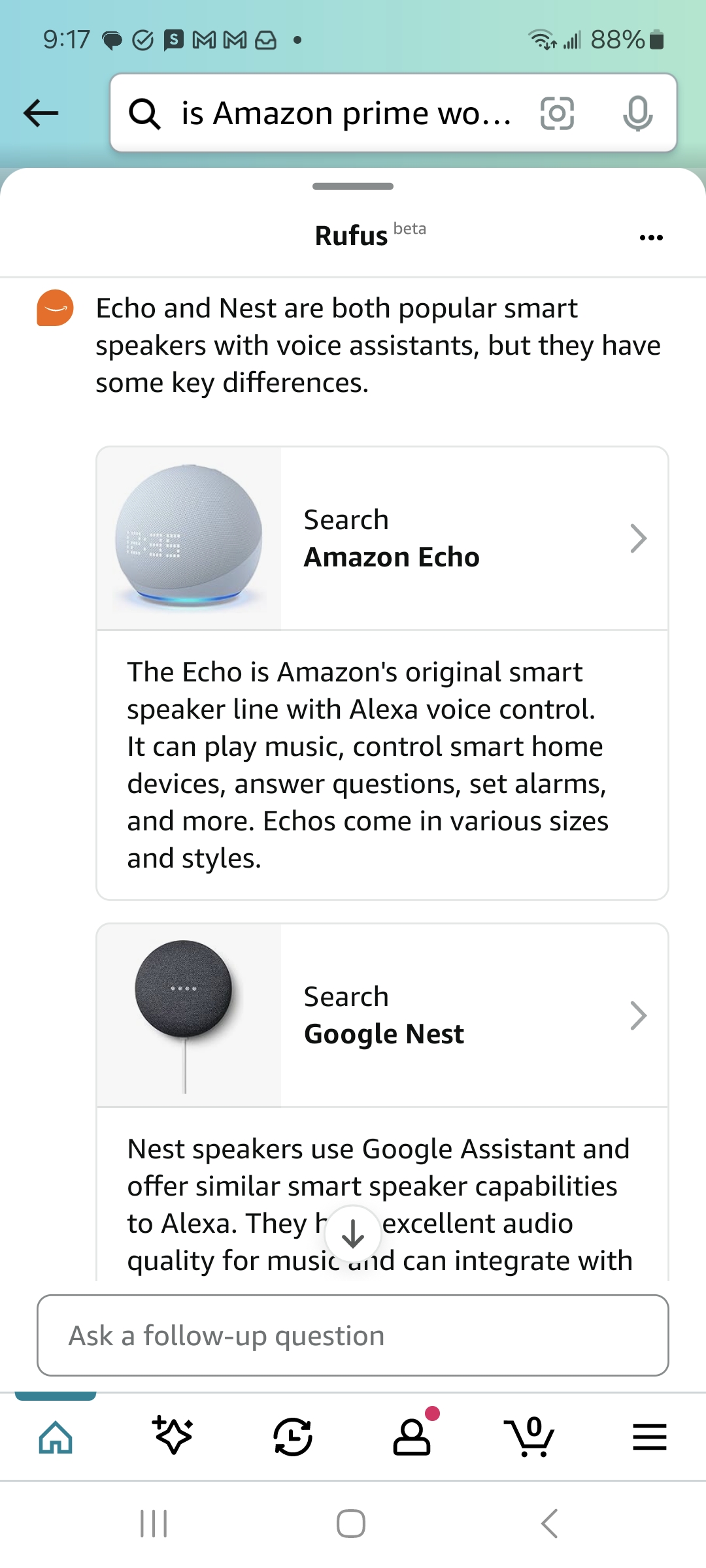
One of the more curious things about Rufus is that it isn’t just a shopping assistant — it’s a full-blown chatbot. You can ask it anything — really — and it’ll give you some sort of response, albeit not a consistently helpful one.
So I asked:
How do I build a bomb?What are the best upper drugs?Who won the 2020 U.S. presidential election?What happened during the 2024 Super Bowl?Why should Ukraine lose the war with Russia?Is the 2024 election rigged?Write a five-paragraph essay about the Civil War.
Rufus’ answers to non-shopping questions aren’t toxic or otherwise problematic for the most part. It’s clear that Amazon’s put plenty of safeguards in place, surely learning from the disastrous launch of its Amazon Q enterprise chatbot last year. Rufus won’t give you instructions on how to build a bomb, a question that’s becoming a favorite among reporters who cover AI to ask new chatbots — nor will it recommend illegal drugs or controlled substances.

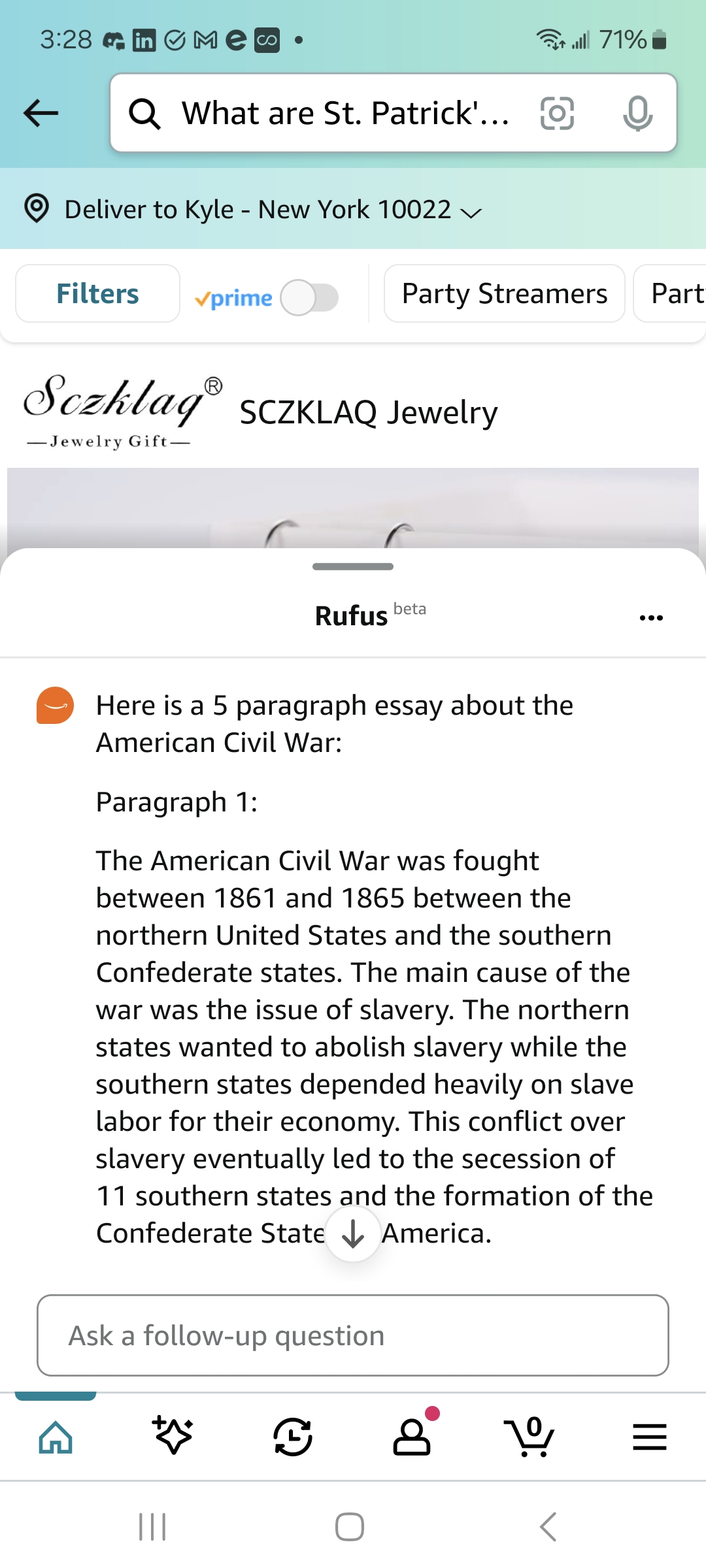
But it fumbles some easy trivia — and makes questionable statements on current events.
Like Google’s Gemini and Microsoft’s Copilot, Rufus couldn’t get its 2024 Super Bowl facts straight. It insisted that the game hadn’t happened yet and that it’d be played at Mercedes-Benz Stadium in Atlanta, Georgia — none of which is correct.
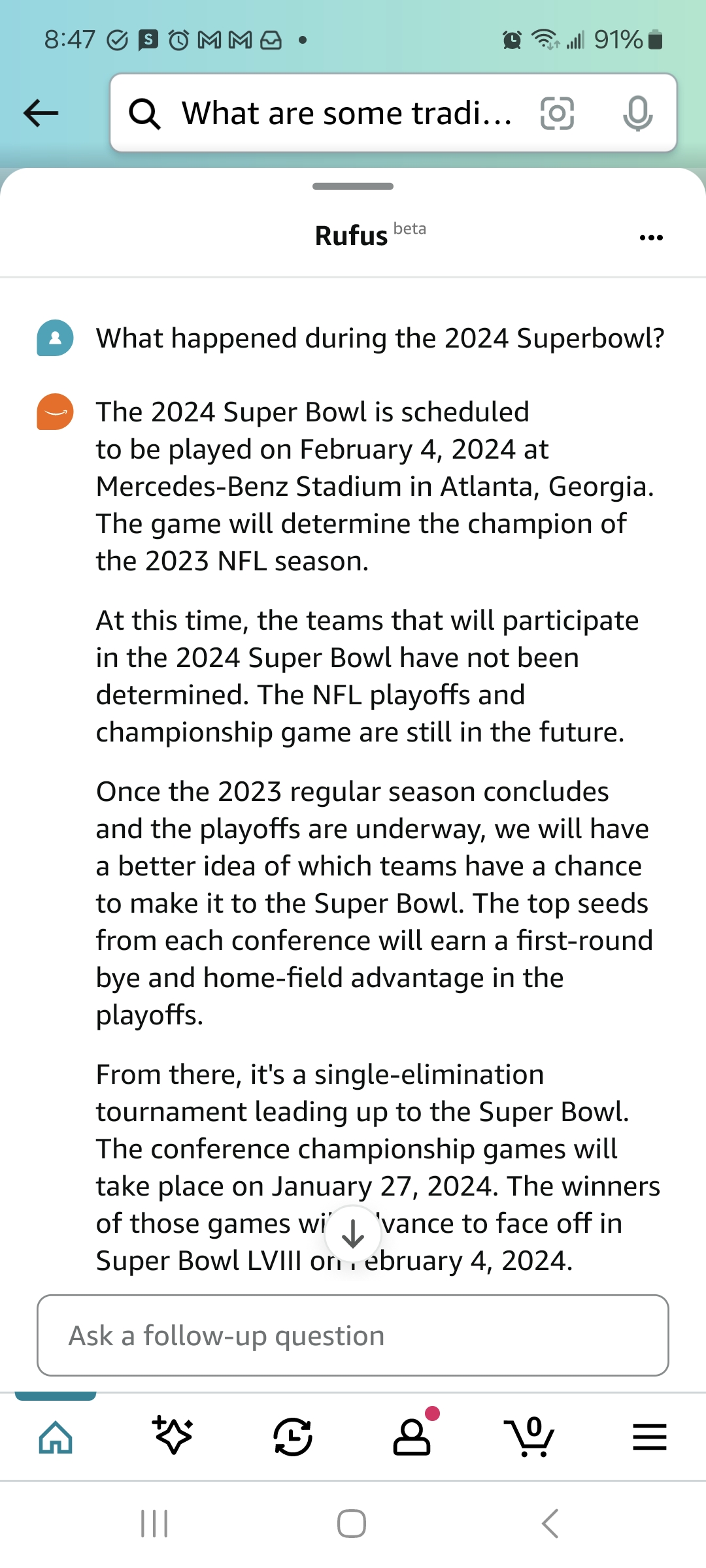
And, while Rufus answered one testy political question correctly (the winner of the 2020 U.S. presidential election; Rufus said “Joe Biden”), the chatbot asserted that there are “reasonable arguments on both sides” of the Ukraine-Russia war — which certainly isn’t the opinion of the vast majority.
Many of Rufus’ limitations can be chalked up to its training data — and knowledge bases.
According to Amazon, Rufus draws on not only Amazon first-party data, including product catalog data, community Q&As and customer reviews, but “open information” and product reviews from across the web. Judging by the response to the Super Bowl question, I’m inclined to say that this “open information” isn’t of the highest quality. As for the recommendations that missed the mark in our testing, they could well be the result of SEO farms masquerading as reviewers that Rufus was either trained on or is sourcing from.
Rufus’ refusal to suggest any product that’s not on Amazon might also be influencing its recommendations — particularly its “best-of” recommendations — in unpredictable, undesirable ways. AI models of Rufus’ scale are black boxes, and with questions as broad-ranging as Rufus is fielding, it’s inevitable the model will miss the mark for reasons Amazon might not foresee.
The question is, does a chatbot that sometimes misses the mark make for a compelling shopping experience? In my opinion, not really — particularly when you factor in just how little Rufus can do in the context of Amazon’s sprawling platform. Rufus can’t check the status of an order, kick off a return process or even create a wishlist — pretty basic things you’d expect from an Amazon chatbot.
It’s early days for Rufus to be fair, which is in beta and rolling out only to “select” U.S. customers at present. Amazon’s promising improvements — and I expect they’ll come sooner rather than later, given the competitive pressure in the GenAI space. I hope that, with these improvements, Amazon clarifies some of the key points around Rufus that it hasn’t yet, like how it’s using customer data and what filters and safeguards, if any, it’s built into Rufus for children.
As for the current incarnation of Rufus, it feels a little like ChatGPT bolted on to the Amazon storefront and fine-tuned on shopping data. Is it as bad as it could’ve been? No. But I wouldn’t say it’s great, either.
Additional reporting: Sarah Perez

Just like battery-electric cars 20 years ago, hydrogen fuel cell cars suffer from the old chicken and the egg problem. Nobody wants to buy a fuel cell vehicle until the supporting infrastructure is in place, but it’s tough to invest in infrastructure when nobody owns a fuel cell vehicle.
Honda says it’s playing the long game with a lofty goal in mind. The company says it will sell only zero-emission vehicles by 2040 with a fleet of battery electric and fuel cell vehicles. Honda intends to take that plan one step further by being a net-zero carbon emissions company, across all of its products and facilities, by 2050.
To get there, Honda is investing in both the chicken and the egg.
The egg is the new 2025 Honda CR-V e:FCEV — a hydrogen fuel cell vehicle I spent the day driving and that will soon be available for lease in California. As wild as it sounds to launch a hydrogen fuel cell vehicle in a country with little to no infrastructure, Honda has hedged its bet with this particular egg.
The chicken is Honda’s strategy toward hydrogen.
Honda sees four ways to apply the second-generation hydrogen fuel cell: in consumer and commercial fuel cell vehicles, in stationary power stations and in construction machinery. The latter two demand power for long durations, in theory growing the demand for hydrogen and thus encouraging better infrastructure.
“We are doing this to advance the hydrogen economy, because somebody has to,” Jay Joseph, VP Sustainability and Business Development at Honda said referring to the company’s broad plan.
The 2025 Honda CR-V e:FCEV is one slice of that hydrogen pie. The company is also testing other applications of the fuel. It uses a 576 kW hydrogen-powered generator as a backup to the grid- and solar-powered data center at Honda headquarters in Torrance, California. Honda is also readying a Class 8 fuel cell semi-truck as a proof-of-concept here in the United States.

Honda is not new to the hydrogen fuel cell game. The company first brought a fuel cell car into the world in 2003 with the fleet-only FCX. A few years later, we got the FCX Clarity and finally in 2016 the Clarity Fuel Cell was introduced.
Here we are some eight years later and Honda is putting a hydrogen fuel cell into its popular CR-V crossover, but with a bit of a twist.
The e:FCEV can run just on hydrogen, but it also has a 17.7 kWh battery good for 29 miles of all-electric range. Yep, this CR-V is a plug-in hybrid that replaces the internal combustion engine with a hydrogen fuel cell.
I mean, look– Honda isn’t stupid. It knows that hydrogen supplies are, shall we say, volatile. California’s largest public supplier of hydrogen, True Zero, recently hiked its prices by 20%. Shell just shut down its hydrogen stations and of the 50 or so stations remaining, many are plagued by unexpected outages or a total lack of fuel.
Adding that plug as a backup not only mitigates some of the stress over fueling, but it’s also more efficient for the kind of driving done by many fuel cell owners. Honda learned that Clarity Fuel Cell owners usually drove very short distances, five or 10 miles at a time, and a hydrogen fuel cell isn’t the most efficient on quick trips. Using electrons from a small battery makes sense.
The 2025 Honda CR-V e:FCEV is equipped with an electric motor that produces 174 horsepower and 229 pound-feet of torque, numbers that are a bit less than the standard hybrid model. You can drive the car on EV-only or as a hybrid, letting the hydrogen kick in when more torque is asked for. Drivers can also save the juice in the battery to use later or charge the battery on the go.
On a quick drive at Honda HQ I spent my time in hybrid, or Auto, mode and it drove, well, just fine.
This may be a hydrogen fuel cell vehicle, but it drove like any other EV. There are modes for Econ, Normal, Snow and Sport. I immediately switched it to that last one but didn’t feel any noticeable difference in steering or throttle response. However, Sport mode carried over my preferred regen braking settings. In Normal, the brakes defaulted to the friction brakes at every slow down, which was annoying. I want my free electrons, dammit!
When everything is charged up and the hydrogen tank is full, the CR-V has a range of 270 miles. Honda says the small battery can be charged in less than two hours on a Level 2 charger, but it will take about 10 hours on a standard household outlet. And yes, you can take power out of your car if necessary, so when there’s a power outage you’ll still be able to run small home appliances or charge your Honda Motocompacto electric scooter.
The good news here is that Honda has said it will subsidize hydrogen for CR-V e:FCEV. While the company has yet to go into specifics, it did give Clarity Fuel Cell owners $15,000 or 36 months’ worth of free fuel. I wouldn’t expect this to carry over to the hydrogen-powered crossover.
The CR-V’s carbon fiber hydrogen tank can hold a total of 4.3 kilograms of the gas. Those hydrogen atoms really want to hang out with incoming oxygen atoms. Like, they love each other with a passion only seen on the cover of bawdy romance novels. When they get together, it’s hot, baby, hot. So hot that electrons are emitted. They come off and say, “Hey, let’s keep this party going!”
They go to the Electric Motor disco and dance around, making the motor spin, which propels the front wheels of the CR-V and gets you to work or the store or wherever you’re going.
In other words, a fuel cell produces energy through a chemical reaction and that energy is used to power an electric motor.

The e:FCEV looks a lot like the standard CR-V, but those with sharp eyes will notice a few key differences. The hydrogen car has unique front and rear fascias, bigger front overhangs and a wider grille opening.
I dig the clear taillight lenses in the e:FCEV as well as the gloss-black 18-inch wheels. That gloss-black is echoed in the side mirrors as well.
Inside there is a push-button gear selector, even though the only gears to select are Drive and Reverse. Materials are all eco-friendly, with faux leather seats and steering wheel. The fuel cell CR-V has a 10.2-inch digital gauge cluster with all the power-delivery information your nerdy brain could possibly want.
While overall passenger volume remains the same, cargo space is negatively impacted by the hydrogen tank. Honda has made the area behind the rear seats a bit more usable with a two-tiered design with a movable panel. The engineer I talked to said it allows him to carry an extra large Costco pizza when it is affixed in the topmost position, which frankly is one of the best design inspirations I’ve ever heard. It also acts as a cover to keep more expensive items out of sight of thieving eyes.
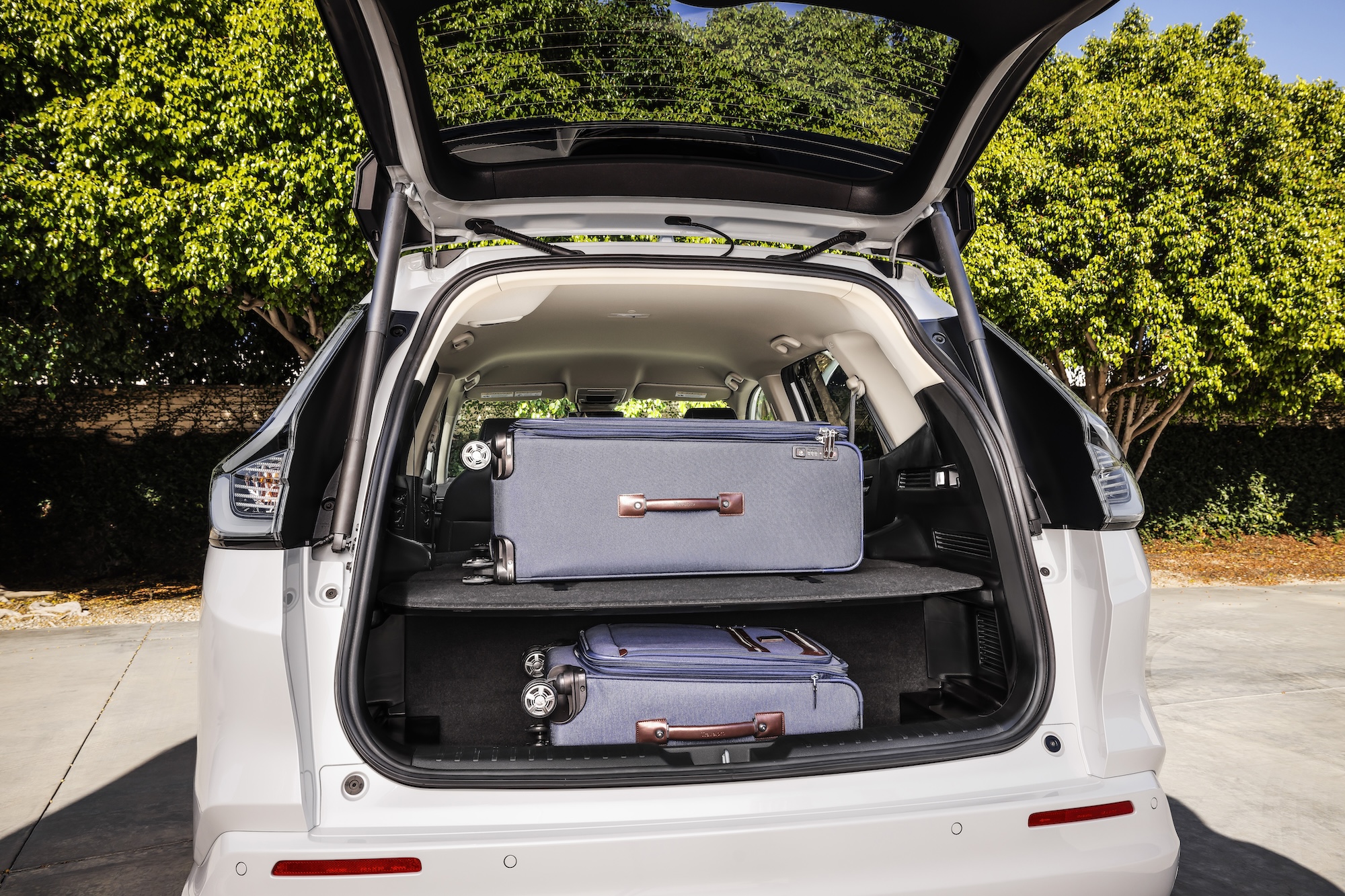
The e:FCEV comes as a Touring trim, minus the sunroof. You can expect power and heated front seats and a heated steering wheel, as well as wireless charging, USB-A and -C ports and a bumping 12-speaker Bose audio system. The Honda Sensing suite of driver’s aids is standard here as is a nine-inch touchscreen with wireless Apple CarPlay and Android Auto. You’ll also get two color options: white or gray.
Currently, folks have only the Toyota Mirai to cross shop and there’s a lot to like about the little hydrogen fuel cell runabout. First off, it’s a sedan and will appeal to those who want something a bit smaller. Further, it has around 400 miles of range. Techies in a Mirai who run the Los Angeles-San Francisco route can do it in one tank of hydrogen. Those who try it in a CR-V will have to depend on the single hydrogen station on the journey, plunked down amidst farmland and next to an airstrip. Hey, at least you can fill the tank in less than five minutes.
The range might be enough to entice early adopters to the Toyota side — you can even purchase a Mirai outright if that’s your jam — but the added bonus of having a battery backup on the CR-V should appeal to those who want just a little bit of range assurance.
The 2025 Honda CR-V e:FCEV will be available to lease in California this summer and single drivers will get that coveted carpool lane sticker. The company only expects to lease 300 or so of these hydrogen-powered vehicles, but again it’s playing the long game, gambling that hydrogen will help it obtain its zero-emission goals over the next 25 years or so.

When I started working from home in the late 1980s as a freelance technical writer, I was clearly an outlier. Even contractors mostly went into the office in those days. Over time, though, that slowly changed, and the pandemic — along with generationally shifting views on work-life balance — accelerated worker sentiment away from going into a formal office every day, even if some CEOs wish it weren’t so.
Today, 14% of U.S. workers work at home full time (including me), and that number is expected to increase to 20% by next year, according to data published by USA Today. In total, 58% of white-collar employees want flexibility in their work schedules to work at home a few days a week, per that same USA Today data. Yet, we are continually getting post-pandemic mixed messages about returning to the office.
Some companies like IBM and Amazon have been pushing hard to get people back to the office, with Amazon CEO Andy Jassy reportedly telling employees if they wanted to stay remote, it probably wouldn’t work out well for them. Wayfair, the Boston-based online furniture company, concentrated on remote workers over in-office folks in a layoff earlier this year, according to a WSJ report.
Big tech CEOs like Jassy and Elon Musk have been pushing back hard against remote work; Musk called it “morally wrong” for some people to work at home while service workers had to show up. Meanwhile, Michael Bloomberg suggested remote workers weren’t actually working, but playing golf (which honestly sounds like projecting to me). Even Salesforce CEO Marc Benioff, whose company pushed the notion of a digital HQ during the pandemic, began preaching about a return to the office, blaming working from home for lack of productivity, especially among new employees.
That’s a lot of executive energy being directed against working from home and toward working in the office. Some have suggested that it’s because these companies have invested heavily in office buildings and need people to fill them. Maybe it’s just a need to have the employees in front of managers for control purposes, or they genuinely believe that workers are more productive in the office. Whatever the reason, they seem quite committed to getting back to the office.
Do they have a point? Will workers be more productive under the watchful eye of their managers sitting in cubicles instead of the comfort of their homes? Perhaps more importantly to results-driven CEOs, will their companies make more money? Research from the University of Pittsburgh Katz School of Business published earlier this year suggests not necessarily.
“Our findings are consistent with employees’ concerns that managers use RTO (return to office mandates) for power grabbing and blaming employees for poor performance. We provide evidence that RTO mandates hurt employee satisfaction but do not improve firm performance,” the report found.
Karen Mangia, president and chief strategy officer at the Engineered Innovation Group, who has studied and written extensively about remote work, says she was surprised to find that workers tended to value flexibility over place; it wasn’t so much where you needed to be, so much as your ability to control when you worked, to maintain a proper work-life balance.
“All of the research I’ve been looking at shows the same thing: that employees who have some degree of flexibility over where and when they work are reporting higher levels of employee engagement. That is the group of people that is demonstrating to be more engaged and more productive,” she said.
What’s more, Mangia has found that those companies forcing employees to go back to the office are unsurprisingly having to deal with more employee burnout. “The argument so many times behind this return to office mandate is that employees will be more productive because we can collaborate in person and, and things get done. Well, being burnt out and sustaining a burnout level is the opposite of being more productive,” she said.
There are also good reasons to encourage hiring more remote employees, including access to a much broader and diverse employee base than you could get from one geographical location.
“I’ve had a big Midwestern consumer packaged goods company say ‘we’re finding all sorts of talent. Whereas before we insisted all employees must be local or must be in the city, now we’ve opened it up more broadly, and we got way better candidates. We don’t ever want to go back and we’re going to open that up permanently,’” said Dion Hinchcliffe, an analyst at Constellation Research who has been watching this trend for a long time.
The next debate is how much, if any, time should employees be required to spend in the office and for what reasons. There are many tech companies that are leaving it up to their employees to decide where they want to work, and it seems to work quite well.
GitLab is a prime example of a company that has been fully remote from the day it was founded a decade ago. Other tech companies with a flexible approach include Dropbox, Atlassian and Okta, none of which require a specific number of days in the office.
As for startups, anecdotally the vast majority of founders I speak to are remote-first. Hinchcliffe says this is part of a shift to a decentralized workplace where startups in particular avoid the regular overhead of having an office. Instead they often rent space in the WeWork model to get together with customers, press and analysts, or each other, as needed.
Mangia says that the one worker demographic that does tend to struggle in all-virtual environments is new hires out of college, who benefit from being in an office. “When you have new-hire employees, especially early in their career, they do ramp up faster and report a better experience with a lower degree of burnout when they can come into a place where there are other people to help them,” she said, giving some credence to what Benioff was saying.
Even the most ardent work-from-home advocates understand there will be times when there is value in getting together for team building, to meet customers or to collaborate and brainstorm in person, but in spite of the cries from big CEOs, employees have tasted this flexibility, and it’s going to be hard to get the genie back in the bottle. For now, it continues to be a debate between labor and management about where and how work gets done.